Open Houses Sunday January 6
Here are today’s Open Houses:

Marblehead Open Houses
Swampscott Open Houses
Salem Open Houses
Beverly Open Houses
Lynn Open Houses
Andrew Oliver
Realtor, Sagan Harborside Sotheby’s International Realty
www.OliverReports.com
617.834.8205
Housing Supply is limited in Marblehead and Swampscott
In my Inventory starts 2019 continuing rising trend article yesterday I commented: While inventory has been increasing steadily for some months, in absolute terms it is still low.
Inventory in New England is always low in the first few months of the year, and activity in the first quarter of the year is very weather dependent, but in this article I show the current inventory (in terms of months of supply*) for Marblehead and Swampscott, as well as for Essex County overall.
Marblehead
Only 3 houses currently for sale under $600,000 and only 18 under $1 million.
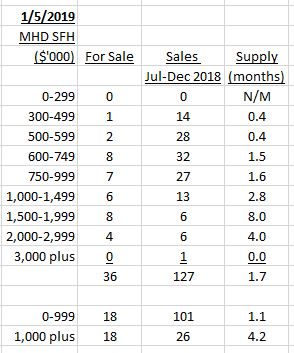
Swampscott
Just 10 houses for sale under $1 million.

Essex County
Very limited supply under $1 million.
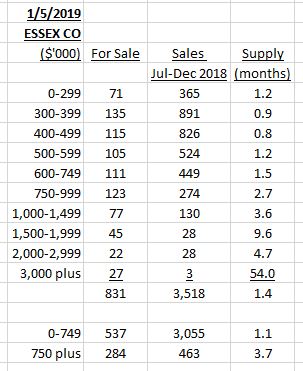
* a market is generally regarded as being in equilibrium between buyers and sellers when supply is 6 months
Comment
The economy is still strong, if slowing somewhat, and mortgage rates have dropped back to 4.5%.
It is early January and it is New England and winter, but there do seem to be opportunities for sellers in many price ranges.
Andrew Oliver
Realtor, Sagan Harborside Sotheby’s International Realty
www.OliverReports.com
617.834.8205
Open Houses weekend January 5/6
The holidays are over, the family has gone home, the stock market has gyrated like it was New Year’s Eve on steroids, mortgage rates looked at 5%, blinked and came back to 4.5% against all predictions, the economy is still doing well and we all want a calm and stress-free 2019.
Meanwhile, here are the weekend’s Open Houses:
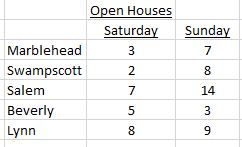
Marblehead Open Houses
Swampscott Open Houses
Salem Open Houses
Beverly Open Houses
Lynn Open Houses
Andrew Oliver
Realtor, Sagan Harborside Sotheby’s International Realty
www.OliverReports.com
617.834.8205
Inventory starts 2019 continuing rising trend
Inventory in New England is always low in the first few months of the year, but it is significant that it has increased Year-on-Year (YOY) for the last 7 months for Single Family Homes (SFH) and for the last 8 months for Condos.
SFH
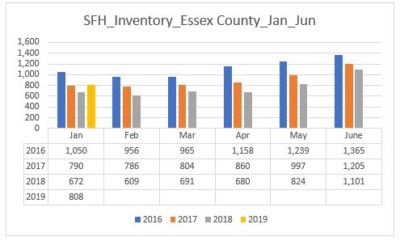
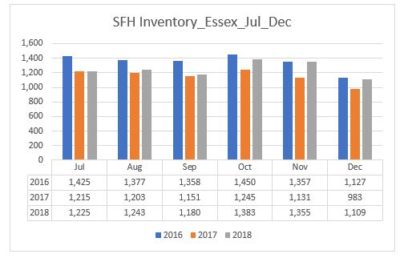
Condos
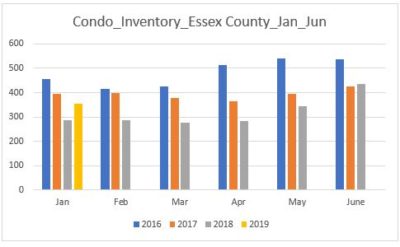
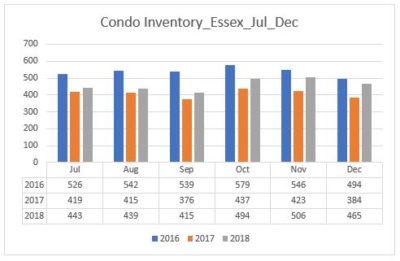
Comment
While inventory has been increasing steadily for some months, in absolute terms it is still low. In tomorrow’s blog post I shall break down the supply by price in local markets.
Andrew Oliver
Realtor, Sagan Harborside Sotheby’s International Realty
www.OliverReports.com
617.834.8205
Essex County 2019 Commercial property tax rates: town by town guide
While most of us look at residential tax rates, far fewer are concerned with commercial tax rates. Yet a healthy commercial business environment can contribute significantly to the attractiveness of a town. The map below shows commercial rates in each of Essex County’s 34 cities and towns, followed by a table comparing residential and commercial rates.
(Click here to download a copy of this map and here to download the table)
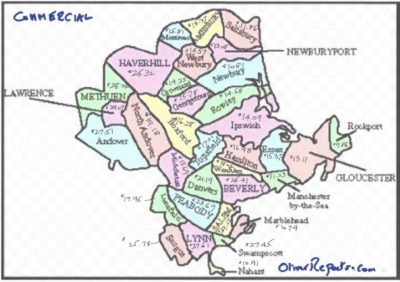
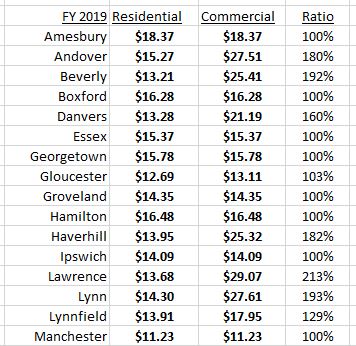
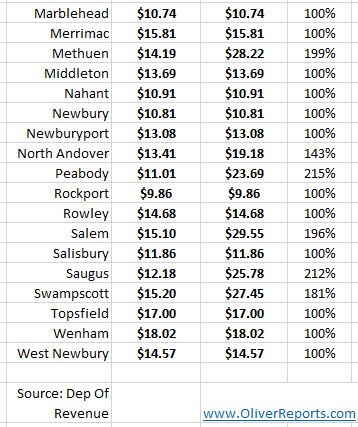
There is a bigger variation in commercial rates than in residential rates
The lowest rate for both residential and commercial rates is Rockport’s $9.86, but while the highest residential rate is Amesbury’s $18.37, there are 11 towns with commercial rates over $20, with the highest being $29.55 in Salem. 20 towns set the same rate for both residential and commercial, while in 3 towns the commercial rate is more than double the residential one.
Why do some towns have different residential and commercial tax rates?
Cities and towns have the ability to increase the percentage of the total tax bill paid by commercial (and industrial and personal) property owners. The percentage of the value of property classified as commercial varies enormously from town to town.
In Marblehead, for example, where residential property is almost 95% of the total, a 50% tax shift to commercial would increase the average commercial tax bill from $6,766 to $10,149, while reducing the average residential tax bill by only $189.
Towns with a higher percentage of commercial property are more likely to shift an increased share of the tax bill to commercial owners.
Andrew Oliver
www.OliverReports.com
Realtor, Sagan Harborside Sotheby’s International Realty
617.834.8205
Open Houses Sunday December 30
Just a handful again today: none in Marblehead or Swampscott, 3 in Salem, 5 in Beverly and 6 in Lynn.
Salem Open Houses
Beverly Open Houses
Lynn Open Houses
Andrew Oliver
www.OliverReports.com
Realtor, Sagan Harborside Sotheby’s International Realty
617.834.8205
Essex County property tax rates 2019: Town by Town guide
Property tax rates for FY 2019 for all 34 cities and towns in Essex County have been announced. Below is a map (which you can download by clicking here), so that you can compare tax rates in neighboring towns, followed by the tax rates for each town the last five years. The first table shows the tax rates in alphabetical order, while the second lists them from low to high.
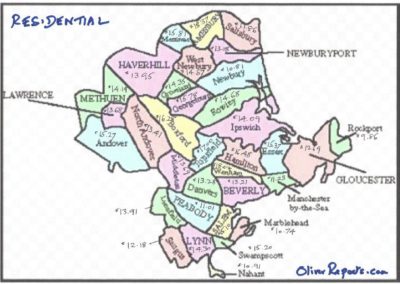
Tax rates for each town
Alphabetically (download a copy of this table by clicking here).
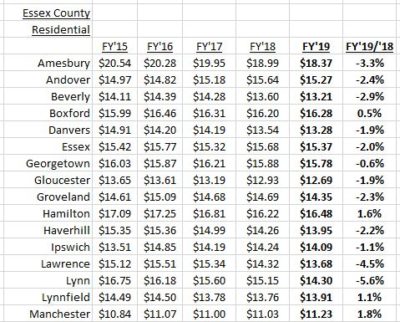
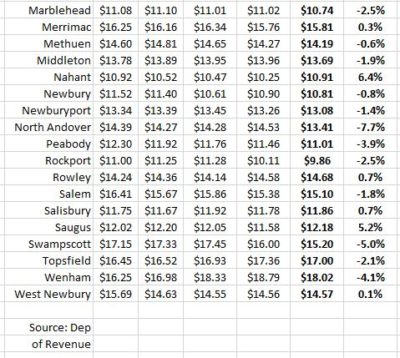
From lowest to highest based on 2019 rates (download a copy of this table by clicking here)
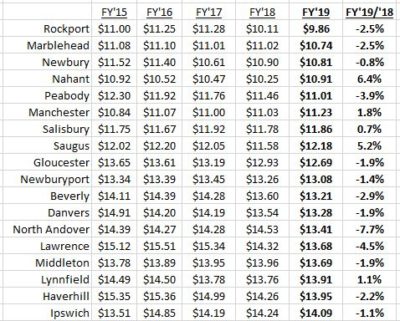

Median and Average Tax Rates
The median tax rate for 2019 is $14.02, down from $14.30 in 2018, while the average tax rate has dropped from $14.17 to $13.95. The highest taxed town, Amesbury, has a rate 31% higher than the County median, while the lowest, Rockport, is 30% below the median. Or put another way, the highest tax rate in Essex County is 90% higher than the lowest.
How property tax rates are calculated
There are two main points to understand:
The dollar amount raised by property taxes is based on a simple formula: the dollar levy for the previous year plus 2 1/2% (Prop 2 1/2), plus any new growth (e.g. new construction), plus debt service.
The tax rate is then calculated by dividing the dollar amount to be raised by the Assessed Value of all property. For FY 2019 (July 2018-June 2019) Assessed Values are based upon sales during 2017. Sales in 2018 will be used for calculating the FY 2020 tax rates.
21 of Essex County’s cities and towns choose a single tax rate, whereby residential and commercial properties are taxed at the same rate. The other 13 cities and towns choose a split tax rate whereby commercial properties are taxed at a higher rate – in some cases a much higher rate.
A separate report on commercial tax rates can be read by clicking here.
For a walk through the tax calculation read How is Marblehead’s 2019 Tax Rate calculated? and How is Swampscott’s 2019 Property Tax Rate calculated?
Tax rate changes in 2019
Of the 34 cities and towns in Essex County, 24 have announced decreases in their tax rate while 10 have had increases approved. Decreases of 5% or more were seen in Andover, Lynn and Swampscott, while 5% or larger increases were recorded in Saugus and Nahant. Bear in mind that a major determinant of the change in tax rates is the movement in Assessed Values. Thus, in a time of rising home prices, a general expectation is that tax rates should be flat to down.
Tax Rates of Neighboring Towns
Where taxes become interesting is when one can compare tax rates in neighboring towns. Many people, especially those moving to the area, whether from Boston or elsewhere, are willing to consider more than one town.There are many factors in the decision about where to live, but tax rates can be a significant influence on the decision, and may become more so with the new limitation on the deduction of property taxes from Federal taxation. Some argue that lower property values offset higher taxes. Frequently, however, residents of highly taxed towns cite taxes as a reason for wanting to move.
Andrew Oliver
www.OliverReports.com
Realtor, Sagan Harborside Sotheby’s International Realty
617.834.8205
Open Houses weekend of December 29/30
Just a handful again this weekend: 2 in Marblehead, none in Swampscott, 4 in Salem, 5 in Beverly and 10 in Lynn.
Marblehead Open Houses
Salem Open Houses
Beverly Open Houses
Lynn Open Houses
Andrew Oliver
www.OliverReports.com
Realtor, Sagan Harborside Sotheby’s International Realty
Housing Inventory continues to climb
The recent trend has continued with year-over-year (YOY) increases in the inventory of Single Family Homes (SFH) in the 34 cities and towns of Essex County for the 6th month in succession and of condos for the 7th month.
SFHs
The first chart shows the first half of the year when inventory was still declining YOY. The second chart shows YOY increases for every month in July to December. Note that inventory levels are pretty well back to 2016 levels, while still well below those of 2014/15:

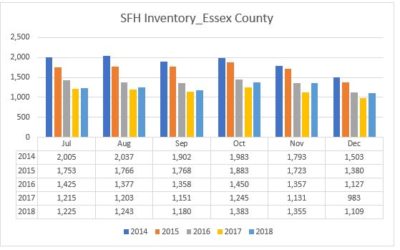
Condos
The first chart shows the first half of the year when inventory was declining YOY until June. The second chart shows YOY increases for every month in July to December. Note that inventory levels are not yet back to 2016 levels, while still well below those of 2014/15:
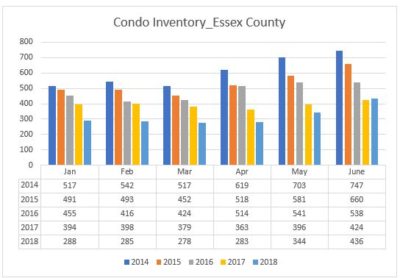
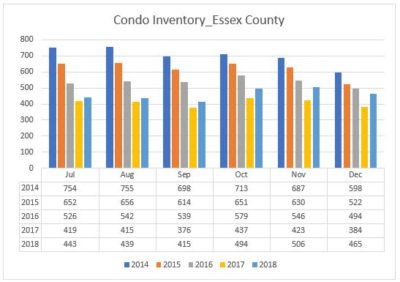
Comment
The December numbers continue the trend commented on for the last several months as rising inventory offers more options for home buyers. Read Is a recession coming soon? for my view on the outlook for the economy and housing market.
Andrew Oliver
www.OliverReports.com
Realtor
Sagan Harborside Sotheby’s International Realty
Tel: 617.834.8205
Is a recession coming soon?
In 1936, British statesman Sir Austen Chamberlain (half-brother of Neville Chamberlain), made a speech in which he said: “It is not so long ago that a member of the Diplomatic Body in London, who had spent some years of his service in China, told me that there was a Chinese curse which took the form of saying, ‘May you live in interesting times.’ There is no doubt that the curse has fallen on us.” “We move from one crisis to another. We suffer one disturbance and shock after another.”
The last comments seem aptly to reflect the last few days and weeks of 2018.
Let me address one important question: is the stock market, which has now declined almost 20% from its high earlier in the year, telling us that a recession is coming soon, or is it just correcting from a sugar high after the huge stimulus from tax cuts and Government spending increases?
And if a recession is coming, what does that mean for the housing market?
In the interests of brevity I shall offer comments in note form:
1. According to many estimates, computer trading accounts for anywhere from 50-60% of equity trading in normal times to 90% on volatile days.Computer trading tends to exacerbate movements, both up and down.
2. The corporate tax cut produced a significant growth in after-tax earnings as companies reported results earlier in the year, leading some analysts to project valuations based on those one-time gains. As it has become clear that corporate earnings growth will return to more normal levels in 2019 so the stock market has corrected to a more sustainable valuation.
3. The Federal Reserve’s mandate from Congress is to “promote effectively the goals of maximum employment, stable prices, and moderate long term interest rates”. Nowhere does it say that the Federal Reserve should seek to boost stock market prices.The late Fed Chairman William McChesney Martin famously said the Fed’s job was “to take away the punch bowl just as the party gets going.”
4. Following the Great Recession the Federal Reserve embarked on a policy known as Quantitative Easing in which it bought Government and other securities in great volumes to inject liquidity into the economy and drive down interest rates to stimulate growth. Those who argue now that the Fed kept the spigot open too long – which it probably did – may be forgetting that for a long time, as Congress failed to enact fiscal policy to stimulate economic growth, monetary policy carried out by the Fed was the only game in town.
5. In February I published What will happen to Home Prices in the Experimental Economy?. The Experimental Economy was the name I gave to the concept of providing a massive fiscal stimulus to an economy nearing full employment. In the article I wrote:”Those who are predicting that strong growth will follow from the major stimulus to the economy may be proved right. If not, the risk is that stimulating the economy at a time of full employment will cause the Fed to raise interest rates aggressively and choke off the hoped for economic growth.”
6. While the increase in the Fed Funds rate has been getting a lot of publicity very recently, the Fed has actually been raising rates – and indicating that it planned to continue to do so – for 3 years, with the first increase coming in December 2015.It could be argued that the more rapid increase in rates this year has been in response to the major stimulus from the tax cuts earlier in the year. It could further be argued that, on the evidence so far, the Fed has been successful in helping to slow growth to a sustainable level, thereby curbing inflationary pressures which would necessitate even higher interest rates.
7. Another part of the reason that economic growth is slowing from 4.2% in Q2 this year to 3.5% in Q3 and an estimated 2.7% in Q4 is the higher costs – and uncertainty – caused by the imposition of tariffs and the “tariff war” embarked on with China. Uncertainty acts to inhibit investment decisions.
8. The economy is still strong as evidenced by the 3.7% unemployment rate and widespread reports of the lack of applicants for job vacancies.
9. Perhaps the strongest sector of the economy has been consumer spending, which by many estimates accounts for 70% of the economy.
Comment
There is a saying in real estate that buyers buy with emotion and justify with logic. The key – both to real estate prices and to the path for the economy – is the level of consumer confidence. While all recorded reports show that level currently to be high, consumer confidence can also be very fragile.
It is too early to project the impact of the daily bombardment of announcements of policies which do not appear to have been given careful thought and analysis, but a period of silence would do a great deal to help restore confidence. That may be wishful thinking, but confidence is a fickle thing.
At the moment it is intact. As long as that remains so the likelihood for 2019 is a slowing, but still growing, economy and a stable housing market.
Andrew Oliver
www.OliverReports.com
Realtor
Sagan Harborside Sotheby’s International Realty
Tel: 617.834.8205
Homebuilders’ confidence plummets – again
Builder confidence in the market for newly-built single-family homes fell four points to 56 in December (after falling 8 points in November) on the National Association of Home Builders/Wells Fargo Housing Market Index (HMI) as concerns over housing affordability persist. Although this is the lowest HMI reading since May 2015, builder sentiment remains in positive territory.
“We are hearing from builders that consumer demand exists, but that customers are hesitating to make a purchase because of rising home costs,” said NAHB Chairman Randy Noel, a custom home builder from LaPlace, La. “However, recent declines in mortgage interest rates should help move the market forward in early 2019.”
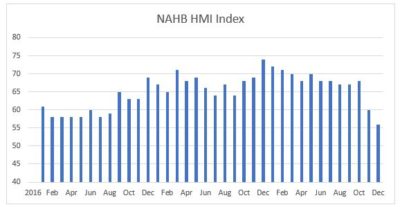
The Housing Market Index (HMI) is a weighted average of responses to survey questions asking builders to rate three aspects of their local market conditions: current sales of single-family detached new homes, expected sales of single-family detached new homes over the next 6 months, and traffic of prospective buyers in new homes. Scores for each component are then used to calculate a seasonally adjusted index where any number over 50 indicates that more builders view conditions as good than poor.
It is perhaps not surprising that builders’ confidence should have dropped recently as the supply of new homes jumped to 7.4 months in October (the November report will be published on December 27), after being in the 5-6 months range for the last 5 years).
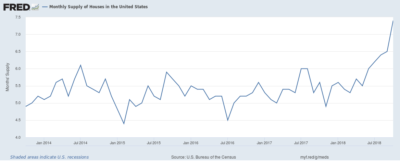
New home sales also fell 8.9% in October to the lowest level since March 2016, while new home prices fell 3.1% from a year ago.
Comment
The figures quoted in this report are for the country as a whole. (The full report, with regional break downs, can be read by clicking New residential sales.) While new home sales account for only about 10% of total home sales, they do give another indication that the housing market is losing momentum, while we have yet to see what the impact of the recent sharp decline in the stock market and political and geopolitical developments may be.
www.OliverReports.com
Sagan Harborside Sotheby’s International Realty
Open Houses Sunday December 23
Here are today’s Open Houses. The number is very small: 1 each in Swampscott, Salem and Marblehead, and 6 in Lynn.
Marblehead Open Houses
Swampscott Open Houses
Salem Open Houses
Lynn Open Houses
There are none in Beverly.
Merry Christmas!
Open Houses before Christmas
The number of Open Houses this weekend is very small: 1 in Swampscott and Salem, 2 in Marblehead and 7 in Lynn.
Marblehead Open Houses
Swampscott Open Houses
Salem Open Houses
Lynn Open Houses
There are none in Beverly.
Merry Christmas!
Why have Mortgage Rates dropped?
The Freddie Mac weekly index of the 30 year Fixed Rate Mortgage (FRM) has dropped from 4.94% to 4.63%, a fall of 0.31%, over the last month. Regular readers of this blog are aware that the FRM closely tracks the yield on the Government 10 year Treasury Note (10T) and so will not be surprised to learn that in the same period the yield on 10T has dropped from 3.24% to 2.91%, a fall of 0.33%. And note that the Fed Funds rate, which is controlled by the Federal Reserve, has been unchanged during this period. While it is widely expected that the Fed Funds rate will be increased by another 1/4% this coming Wednesday, this increase will have no direct impact on the FRM, although it may well have on Adjustable Rate Mortgages.
For an explanation of the link between the FRM and 10T read Mortgage rates head for 5% .
The question of why mortgage rates have dropped becomes, therefore, why the yield on 10T has dropped.
What drives the yield on the 10 year Treasury?
In general terms, the yield on the 10T is seen as a reflection of the outlook for the US economy and inflation, but it is also influenced by the demand for Treasuries from domestic and international investors seeking a “safe haven” in times of uncertainty.
Outlook for the US economy
The argument for the huge tax cuts earlier this year was that they would encourage investment which would lead to much higher economic growth than we have seen in recent years. The Administration talked of 4% growth, a figure it was claimed would lead to a reduction in the budget deficit, rather than the increase which would materialize if growth remained at the 2- 2.5% level. For my views last February and how this would influence real estate prices read What will happen to Home Prices in the Experimental Economy?
As 2018 draws to a close, it is clear that growth is slowing in many parts of the world. The US economy is performing strongly, although there are concerns about the impact a protracted tariff war with China could have on growth.
The chairman of the Federal Reserve has made two statements about interest rates in recent weeks. The market interpreted the first as suggesting that there could be several more rate increases in 2019, and the second as suggesting there may be only one more. Mr. Powell’s remarks this coming Wednesday will be analyzed very carefully, especially to see if the Fed makes reference to a slowing in the economy.
Inflation
This is perhaps where there is the greatest divide amongst pundits. Despite all the reasons that inflation should be rising faster than it is, it isn’t. In recent months, the oil price has dropped sharply and that has been a restraining factor on the overall price level. Those who see no signs of inflation picking up steam argue that interest rates do not need to be increased further. The arguments for continuing to increase interest rates include concerns that the full employment level in the US must lead to wage pressures, while unless interest rates are allowed to return to the sorts of levels we have seen over the last 30 years or so, the Federal Reserve will not be in a position to lower rates to stimulate the economy if we are to enter the recession some economists are forecasting for as early as 2020.
Treasuries as a safe haven
Here is an article from The Balance explaining Who owns the National Debt. It makes interesting reading.
Regardless of all the theories about, for example, whether China will stop buying Treasuries as part of its tariff war with the US, the fact remains that yields on US Government securities are far higher than those offering in other developed and stable counties.
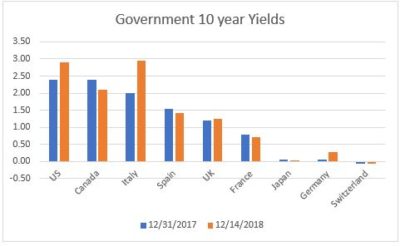
Note that the yield on the US 10T has increased this year, as the Treasury has had to sell more Notes and Bonds to finance the growing budget deficit.
The only other country showing a significant increase in yields is Italy which is embroiled in a dispute with the EU over its budget.
The biggest factor in safe haven buying is concern about geopolitical developments. In times of uncertainty, investors buy Treasuries. Assuming that the reader of this blog is not immune to the daily bombardment of developments domestically and internationally, I shall not list them here. Suffice it to say, we are going through a period of great uncertainty.
Summary
There are many uncertainties facing all markets at a time when the supply of homes for sale has been increasing for several months. While the economy remains strong and employment high, there is no obvious reason to expect home prices to fall significantly. It is likely that some buyers were over- optimistic (or desperate) earlier in the year and that we are now seeing greater equilibrium emerging in many markets between buyers and sellers.
Andrew Oliver
www.OliverReports.com
Sagan Harborside Sotheby’s International Realty
Open Houses Sunday December 16
Here are today’s Open Houses. Click here to read “Why have Mortgage Rates dropped?”
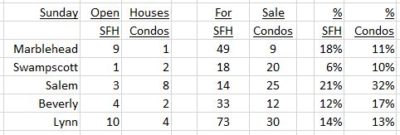
Marblehead SFH Open Houses
Swampscott SFH open Houses
Salem SFH Open Houses
Beverly SFH Open Houses
Lynn SFH Open Houses
Marblehead Condo Open Houses
Swampscott Condo Open Houses
Salem Condo Open Houses
Beverly Condo Open Houses
Lynn Condo Open Houses
www.OliverReports.com

Recent Comments